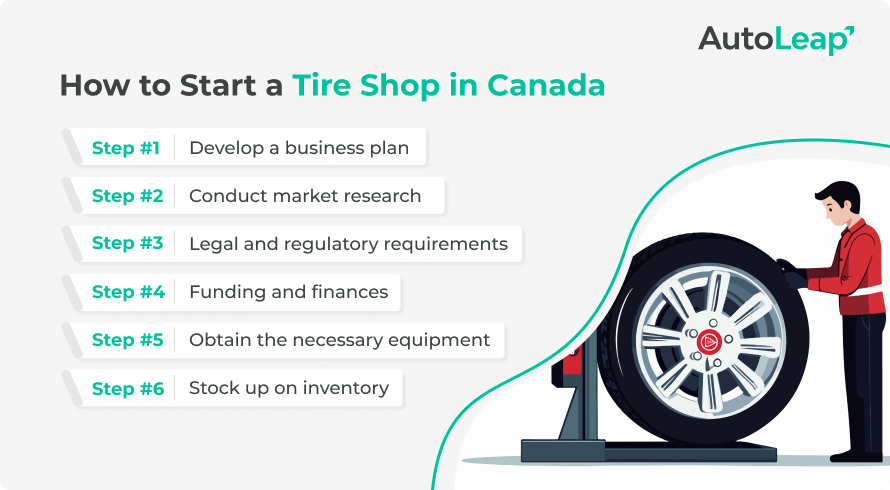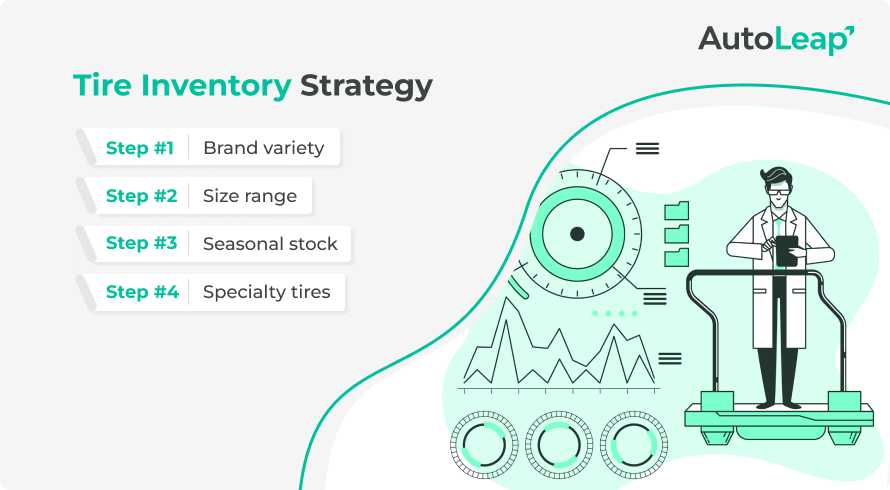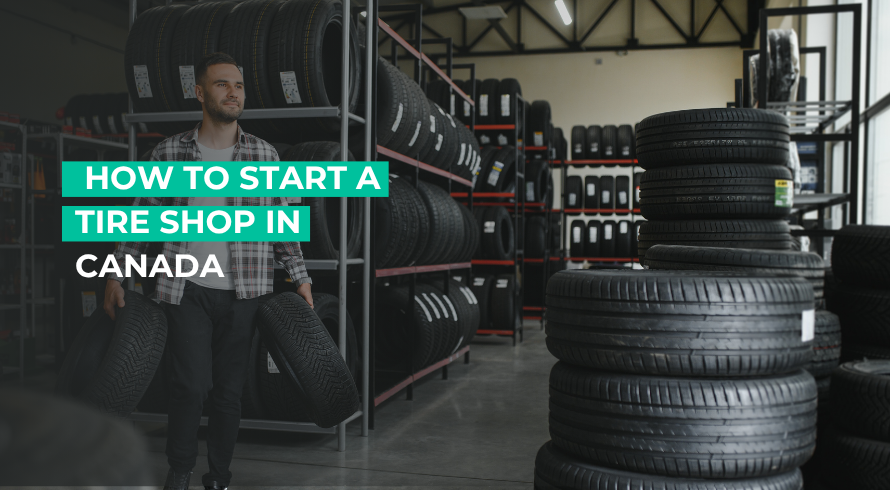The tire dealer industry in Canada reached a market size of $5.9 billion in 2025. This was a huge rebound from the sharp revenue drop during the COVID-19 years of 2020-2021. However, Canada has a vast geography and distinct seasonal changes and the demand for tires remains consistent year-round. Whether it’s summer to winter tire changes or personal to heavy-duty commercial use. There is a range of opportunities, which means starting a tire shop in Canada can be profitable. So, let’s help you lay the right foundation. In this guide, we’re breaking down everything you need to know about starting a tire shop in Canada.

1. Develop a business plan
No matter which business or industry you want to set up shop in, you need to have a business plan. A business plan is not just that document that helps you secure funding. It is a roadmap for you and other stakeholders that outlines which direction the business is headed in. It helps you stay on track. Let’s start with the basics of what your tire shop’s business plan will include:
Executive summary
This gives you an overview of your business. Here you can chart out:
- The name of the tire shop
- Your mission
- Unique selling proposition
- Short-term and long-term goals
Company description
Here, you can get into details about your business structure.
- Is it a sole proprietorship, partnership, or corporation?
- What are your service offerings?
- Are you selling tires, or will you offer accompanying services such as mounting, balancing, alignments, or seasonal tire storage?
Market analysis
Without having a clear understanding of the market, you can’t launch a full business. Research the following:
- Demographics
- Car ownership statistics
- Traffic volumes
- Income levels
This market research will include the area you’re setting up shop in, plus the surrounding areas.
Select a location
This market analysis will also inform the location you select. When you’re choosing the location of your tire shop, consider:
- Good visibility from the road
- Easy access to the tire shop
- Distance from the suppliers
- Accessibility to auto repair shops
- Existing competitors in the area
Competitive analysis
Identify the main competitors in your area. Understand what they are offering and learn about their services, pricing, and unique selling proposition. Check out their customer reviews.
Once you know about your direct and indirect competitors, you will be in a better position to identify the gaps. If your competitors, for example, close on the weekends or don’t have winter tire packages, you can differentiate your tire shop there.
Operations plan
Here, you can go into detail about your shop’s layout.
- What equipment will you need?
- How many people will you need to hire?
- What will the employee roles look like?
- What are your hours of operation?
- Who are your main suppliers?
This is a good place to add any details about scaling your tire shop. For instance, if you need more technicians, or will you expand to multiple locations?
This operations plan will guide your decision-making process. You won’t have to spend extra time on these smaller decisions later on.
Marketing and sales strategy
Before you launch your business, you also need to have a clear marketing plan laid out. Think about:
- Digital marketing (SEO, social media, paid ads)
- Local direct outreach
- Other promotional tactics (opening sales, seasonal discounts, referral and loyalty programs)
Financial plan
This will include all your costs, any operational expenses, the cost of equipment, projected income, and a break-even analysis. You can even go a step further and add a cash flow forecast for the first 1-3 years.
This business plan will be your guiding light when making decisions and pitching to investors and lenders.
2. Conduct market research
Let’s dive deeper into the kind of market research you need to do before launching your tire shop. Without having a clear understanding of your local market, you will be shooting in the dark. Here’s what you can look into.
Population and car density
Check data from Statistics Canada or go to your province’s open data portal. You need to know the number of vehicles per capita in the area you want to operate in. The more cars in the area, the more opportunities your tire shop will have.
Vehicle types and preferences
The vehicle types will also vary from city to city. For example, in Calgary or Winnipeg, snow and ice are common. Winter tires are a must. In comparison, Vancouver residents can work with all-season options. Apart from this, fleet vehicles, rideshare usage, and heavy-duty trucks will influence the type of tires your customers will need.
Local economic conditions
Also, keep a close pulse on the population of the area. Is it an area with a growing population and a healthy economy? That will equate to more cars and more business.
Plus, you also need to know the average household income levels of the area. Higher household income means a willingness to invest in quality tires and vehicle maintenance.
Competitor mapping
Your research needs to include a deep understanding of all your competitors. List down all within a 10-15km radius. For research,
- Go to their shops
- Study their websites and pricing
- Note down the services they offer
All of this will help you identify any gaps in their system. For example,
- Check if they have proper tire storage
- Do they have waiting areas?
- Can customers book appointments online?
- Do they provide educational content on their website?
Learn what the customers say about them. Check their online reviews. Use all the negative complaints about them to fuel your strategy.
With this information in hand, you can create your inventory list and services offered and form your pricing strategy.
3. Legal and regulatory requirements
Setting up a legal tire shop in Canada comes with several federal, provincial, and municipal regulations. Here’s what you need to keep in check as you figure out the legalities.
Business registration
Once you’ve chosen a business structure, you will need to register the name through your province’s corporate registry. A sole proprietorship is easier to register, while a partnership will offer limited liability. You can choose whichever works for you.
Business number (BN)
You will also need a business number (BN). You can get that from the Canada Revenue Agency (CRA). This will help you when tax season comes around. Plus, you will also need it to register for GST/HST.
Municipal licensing
Get in touch with your local city hall. They will give you the business license. A few basic requirements include a fire inspection, a parking plan, and a signage permit.
Zoning compliance
Check the zoning laws to see if your tire shop will get approval in the chosen location. These laws affect the kind of work you can do and your hours of operation. Your tire shop will need to comply with these laws to begin operations.
Environmental and waste management
Tire shops generate waste from used tires and chemicals. You will need environmental permits to handle any waste and the disposal of hazardous materials. Every province in Canada might have different tire recycling procedures. In Ontario, for example, you will need to register with the Resource Productivity and Recovery Authority (RPRA). They have all the guidelines laid out. You can use those to plan how you will responsibly dispose of old tires.
Workplace safety
You also need to make sure your tire shop follows the safety laws. For that, you can register with your provincial workers’ compensation board. This will help you register with health and safety procedures.
It’s better to make sure your tire shop is legally compliant. You will avoid costly penalties. This also helps you build credibility with customers and suppliers.
4. Funding and finances
Do you know how much it will cost to open a tire shop? You will need a very clear understanding of start-up costs, expenses, equipment costs, licensing costs, and marketing and branding expenses.
Startup costs breakdown
Let’s get into the details of the starting costs you’ll need to account for.
Lease and renovations
Do you plan to lease or purchase the property where you will set up your tire shop? The cost for either option will depend on your shop’s location, size, and any renovations that are needed.
Equipment and tools
You will need tire changers, balancers, lifts, and other essential equipment based on the services you intend to offer.
Inventory
Your inventory will include common tire sizes and brands when you’re starting. The tire shop will need that initial investment.
Insurance and licensing
All the insurance and licensing we discussed previously will also have some fixed costs attached. Have a clear estimate of what this will amount to.
Marketing and branding
Your auto shop needs a website, logo, signage, and other promotional materials for opening. You will need to hire a team or a few in-house people to help you set all of this up.
Hiring and training staff
You also need a skilled and knowledgeable team. For that, there will be an initial cost of hiring, which includes advertising for the positions. Then comes the wages, the employee benefits, and the training costs you need to account for.
Financial best practices
A few things to keep in check as you’re starting off
- Open a business bank account that will help you manage cash flow and simplify bookkeeping.
- Get on board with tools like QuickBooks to track income, expenses, and taxes.
- If you need financing, explore your options with banks, credit unions or even the Canada Small Business Financing Program.
- Keep 3-6 months of operating expenses in reserve for any unexpected events popping up.
Pro tip: keep your business and personal finances separate. This will keep things organized and protect your assets.
5. Obtain the necessary equipment
Now, this is the real thing. Which equipment do you need for your tire shop? You need tools to improve efficiency. You need equipment that will enhance the quality of your services. Here is a list of essential equipment you can stock up on:
Tire changers
You can decide if you want semi-automatic or fully automatic machines. This will depend on your budget and the expected volume of cars.
Wheel balancers
Your tire shop will need these to balance tires for a smooth ride. You can go for either static or dynamic options.
Vehicle lifts
There are multiple lift options available. 2-post and 4-post lifts help with safe and convenient tire installations and inspections.
Air compressors and tools
Your tire shop needs these to inflate tires and power pneumatic tools like impact wrenches.
Alignment machine
This is not a must-have. But it is a good option if you plan to offer wheel alignment services.
Jack’s, bead blasters, and torque wrenches
These are a few essential tools for manual tasks you need to keep handy in your tire shop.
Waiting area essentials
Have a nice waiting area for your customers with comfortable seating, a coffee machine, and a Wi-Fi connection. Small details like these make a huge difference to customer satisfaction.
A few extra tips for tire shop equipment
Before you buy your tire shop equipment, a few things to consider:
- Invest in commercial-grade equipment. It might cost more, but it will be durable and reduce downtime.
- If cash flow is tight, consider leasing.
- Explore refurbished equipment. This will help you save cash without compromising on safety.
At the end of the day, the quality tools will improve turnaround time, and it will boost customer trust.
6. Stock up on inventory
If you have a tire shop, you need to have a solid inventory of tires, right? You need to have the right inventory for customer satisfaction and profitability. Here’s how you can go about it:
Tire inventory strategy

Brand variety
Give your customers a choice of budget, mid-tier, and premium options. Check brands such as Michelin, Continental, Firestone, Cooper, or Uniroyal. Having a good variety gives your customers enough options to choose from.
Size range
Through your research, you will know what the popular sizes are. Keep those in stock for the most common vehicles. For example, sedans, SUVs, trucks, or even hybrid vehicles.
Seasonal stock
When fall comes around, people start to switch to winter tires. While all-season tires sell more during spring and summer. You can adjust your inventory accordingly based on the season.
Specialty tires
If your tire shop happens to be near a rural or farming area, it’s a good idea to have off-road and utility tires as well.
Supplier management
Your suppliers can be national distributors like OK Tires, Fountain Tire, or Kal Tire. Make sure to build and nurture good relations with them.
Opt for just-in-time delivery options. This will reduce the warehouse needs, and you won’t have to worry about keeping stock for long.
Plus, if you’re getting stock in bulk, make sure to get bulk pricing and also negotiate any return policies.
Inventory control
- You can use inventory management software. This will help you track sales trends, reorder levels, and even seasonal patterns. Keeping a close eye on stock will help reduce extra expenses and last-minute stock shortages.
- Consider rotating older stock to reduce aging and dry rot.
- A great way to create a recurring revenue stream is to offer tire storage services for winter and summer changeovers.
With a well-managed inventory, you will be able to take on walk-ins quickly. Plus, you will be able to minimize losses from overstocking tires.
Wrapping up
If you’re opening a tire shop in Canada, you need more than just basic knowledge about tires and the automotive industry. You need market awareness, a deep understanding of the business, and a commitment to customer service.
So, whether you’re opening in a small town or a large metropolitan city, you need to prepare and do your research. This guide is a great first step in setting up your tire shop for growth and profitability.
FAQs
How much money do you need to start a tire shop?
You will need around CAD 50,000 – $250,000, depending on inventory, equipment, and most importantly, the location of your tire shop.
What permits do I need to open a tire shop in Ontario?
To open a tire shop in Ontario, you will need a business license, a zoning permit, and compliance with tire recycling regulations from RPRA.
Do you need a license to open a tire shop?
Yes, you will need a municipal business license and additional environmental and zoning approvals to open a tire shop.









